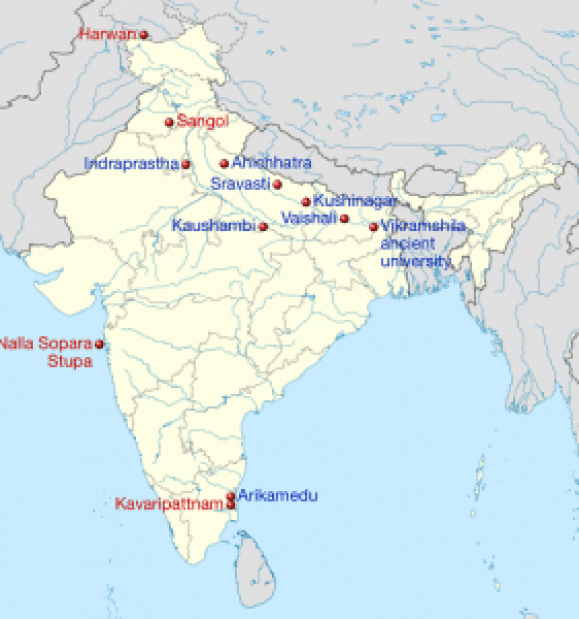India’s Silk Road Ambitions and China’s OBOR Intentions
Although it has been China who has laid claim to the de facto Silk Road concept in recent years, it should not be forgotten that China only represented, depending upon perspectives, either the start or the end of the routes. These can still be seen in China itself, the blue lanterns of Muslim restaurants in Xi’an, the capital of the time, belong to the descendants of the Muslim traders who settled in China all those centuries ago.

At the other end, prayers and invocations to the Gods remain carved into the rock caves at Dunhuang, as travelers faced up to the perils of crossing the infamous Taklimakan Desert. The name, in Uyghur, means, “Go in and you won’t come out”. Those that traveled that way, along a route immortalized and fantasized in the 16th century Chinese epic “The Journey to the West” found that they had two choices – head north and cross the Pamir range of mountains into Afghanistan and Central Asia, or head south into Tibet and then India. Both were dangerous.
The two most famous Silk Road travelers, Marco Polo and Ibn Battuta, passed through India en route to China. Polo traveled India’s eastern Malabar Coast, visiting Tamil Nadu, and had good things to say about traders from Gujarat that he met there. Battuta travelled south from Afghanistan into what are now parts of Pakistan, borrowed money from merchants in Multan in the Punjab, then lived in Delhi for seven years before making his way south to the Province of Sindh and exiting from what is now the Chinese invested Port of Gwadar. An excellent summary of Battuta’s India journey can be found here.
In fact, India had sixteen key Silk Road trading sites in ancient times, more than any other country excepting China. These extended from the far north, ran all the way along the southern Himalayan border with Tibet (Lhasa was also a Silk Road trading city and inland port) and along both east and west coasts.

The northern routes as can be seen in the map above were essentially mountain passes, both dangerous in terms of being controlled by local warlords, being swept by unpredictable bad weather, and impassable during the winter months. There would be no cross border trade between China and India when the snows set in, except by the sea routes. Here, the Port of Calcutta began to develop, transporting tea, herbs, and madder (a dye used in coloring Buddhist robes) both to and from Lhasa, directly to the north. Even today, Calcutta has the world’s largest Tibetan diaspora, again descendants of ancient traders. Although these routes, such as the crossing at Nathu La still exist, they are unsuitable for modern transportation needs, and both China and India are wary of existing border disputes mainly originating from the Chinese “liberation” of Tibet in 1950.
RELATED: China Needs To Solve Disputed Territorial Claims Before OBOR Can Become Effective
This means that the majority of the previous Indian Silk Road corridors are not viable. Getting pack animals and caravans across Himalayan mountain passes is hard enough – creating the road and supporting infrastructure to make them profitable to fit today’s commercial environment would be quite another.
India, however, is examining and has committed to new options for overland route development, such as creating potential paths to China through Bangladesh and Myanmar. In fact, India has commenced work on connecting India to Bangladesh via upgrading rail routes with the Tripura Sundari Express, traversing from New Delhi to Agartala, and the India-Bangladesh Broad Gauge Rail link, connecting Agartala in India with Akhaura in Bangladesh. Concerning Myanmar, India has also begun work on the India-Myanmar-Thailand highway project, a 3,200km route planned to link India with ASEAN. China lies just to the east.
It should be noted that both the Bangladesh and Myanmar projects take place over extremely difficult terrain and will involve high technological engineering solutions – and financing – to accomplish. China, however, when discussing One Belt, One Road (OBOR) projects tends to have a blinkered view, and only announces projects as “OBOR” when its own political interests or those of Chinese companies are highlighted. This is rather a one sided perspective (It is also why Silk Road Briefing was developed – to give the picture beyond China). India’s efforts in linking itself to Bangladesh and Myanmar fall exactly within the Chinese President Xi’s call to link the Eurasian landmass. Beijing’s media bias, however, when concentrating on Chinese-only initiatives, therefore, is not entirely helpful when trying to assess the complete development picture, and other national interests and involvement. The Silk Road at the China end was a terminus, not the entire route – hence the importance of India’s development interests in linking the country to Bangladesh and Myanmar, and onto China.
RELATED: Sagarmala: Developing India’s Ports to Aid Economic Growth
Having explained India’s overland Silk Road position, this essentially leaves India’s Ports as the maritime part of the equation. India’s Ports have not been developed at the same pace of China’s over the past two decades, although that is now rapidly changing. There are two motivations: one being India’s emergence as a major global manufacturing hub in its own right.
The Indian Ports Bill is intended to speed up development, and this will spur investment into Ports on both its east and west coasts. India needs to – about 95 percent of India’s trading by volume and 70 percent by value is through maritime transport. It is serviced by 13 major ports, all of which require upgrades. To facilitate this, the port industrial sector has been liberalized, under a project called Sagarmala. As part of this, the Indian Government has allowed Foreign Direct Investment (FDI) of up to 100 per cent under the automatic route for port and harbor construction and maintenance projects. The government has also initiated the National Maritime Development Programme (NMDP), an initiative to develop the maritime sector with a planned outlay of US$11.8 billion. This will transform India’s Ports, which will take their place along the Maritime Silk Road routes.
The second motivator is security. India has a powerful Navy, but it has been wary of China’s military buildup, due to China’s so-called “String of Pearls” strategy and its development of reefs and sand bars within the South China Sea. To keep China at arm’s length, add a regional naval Asian balance, and interact more with oceanic ASEAN, India is boosting its naval capabilities and will shortly be joining the Malacca Straits Patrol, which also includes the navies of Indonesia, Malaysia, Singapore, and Thailand. This will provide better navigational and shipping data across the region to transiting vessels and other countries shipping as well as provide security. It is aimed at protecting against piracy, but India’s involvement will not have gone unnoticed by the Chinese. This military capability will also assist in upgrading India’s Ports and communications.
To this end, China needs to be careful what it wishes for. Expanding and developing the OBOR is emphatically not purely a Chinese play, and although they may have invented the “One Belt, One Road” term, in reality other nations are also developing along exactly those lines. The OBOR initials is really now synonymous with purely Chinese invested interests (indeed the official OBOR website section of participating enterprises suggests this), while the development of the Silk Roads overland and maritime routes have implications that are of great strategic interest to nations such as India, and beyond. The true new Silk Road reach extends way beyond China’s sphere, and other nations – such as India – are developing their own Silk Road ambitions.
This means that conversations about India’s OBOR ambitions at China’s Shanghai Cooperation Organisation, which has recently admitted both Pakistan and India as members, are about to become a whole lot more interesting. Is India involved? Yes. But how India – and other nations – proceed may not always quite fit in with China’s intentions.
About Us
Silk Road Briefing is published by Asia Briefing, a subsidiary of Dezan Shira & Associates. We produce material for foreign investors throughout Eurasia, including ASEAN, China, India, Indonesia, Russia & Vietnam. For editorial matters please contact us here and for a complimentary subscription to our products, please click here.
Dezan Shira & Associates provide business intelligence, due diligence, legal, tax and advisory services throughout the Asian and Eurasian region. We maintain offices throughout China, South-East Asia, India, and Russia. For assistance with OBOR issues or investments into any of the featured countries, please contact us at silkroad@dezshira.com or visit us at www.dezshira.com.
Related Reading:
Silk Road and OBOR Business Intelligence
Dezan Shira & Associates´ Silk Road and OBOR investment brochure offers an introduction to the region and an overview of the services provided by the firm. It is Dezan Shira´s mission to guide investors through the Silk Road´s complex regulatory environment and assist with all aspects of establishing, maintaining and growing business operations in the region.
An Introduction to Doing Business in India 2017
An Introduction to Doing Business in India 2017 is designed to introduce the fundamentals of investing in India. As such, this comprehensive guide is ideal not only for businesses looking to enter the Indian market, but also for companies who already have a presence here and want to stay up-to-date with the most recent and relevant policy changes.
China’s New Economic Silk Road
This unique and currently only available study into the proposed Silk Road Economic Belt examines the institutional, financial and infrastructure projects that are currently underway and in the planning stage across the entire region. Covering over 60 countries, this book explores the regional reforms, potential problems, opportunities and longer term impact that the Silk Road will have upon Asia, Africa, the Middle East, Europe and the United States.









